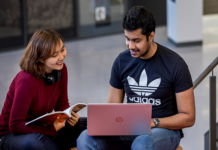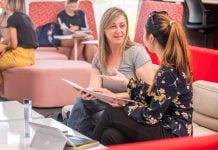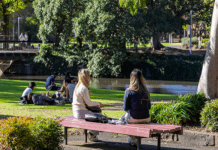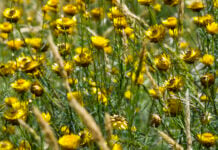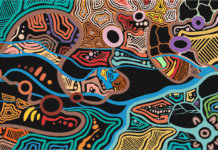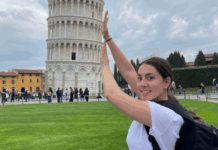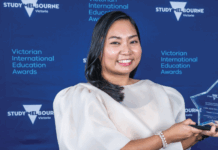A passion for art and caring for people has led talented Master of Art Therapy student Laura Peacock to success in the Archibald Prize, one of Australia’s most prestigious art contests.
In an outstanding achievement, Laura’s portrait entry was one of this year’s 57 finalists in the famous art competition, which received more than 1000 entries from across Australia.
The Archibald Prize is an annual portrait competition held at the Art Gallery of New South Wales. Trustees of the Art Gallery of NSW judge the competition, with finalists displayed in an exhibition at the Gallery.
Laura’s artwork, Peter at Home, is a portrait of Peter O’Neill, a lifelong creative whose experience spans literature, radio, theatre and music.
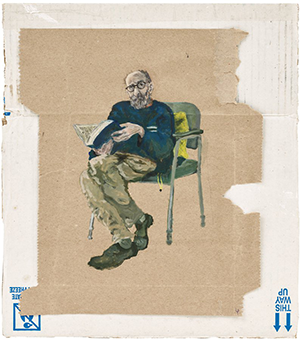
Laura spent time as Peter’s support worker and the pair bonded over a shared love of art. The portrait highlights the link between caring and art, and how art can be used as a healing tool – concepts the Art Therapy student has been keen to explore.
“I think that especially because my entry was created with a client that I was supporting, the work really synthesises care and art, which is the driving force in Art Therapy.
“Peter and I connected over our shared appreciation of the arts and that was what led to the work. I think that the work was a little therapeutic for both of us, even if that wasn’t the intention.
“For me it’s the most successful portrait I’ve ever completed and I think that shines through because of the caring connection we have. For Peter, being seen and appreciated in such a prestigious public setting is a testament to him.”
Laura said that they didn’t create the portrait with the Archibald prize in mind, and that it was Peter who encouraged Laura to enter the competition for the first time.
I think that especially because my entry was created with a client that I was supporting, the work really synthesises care and art, which is the driving force in Art Therapy
“I mostly just wanted to paint Peter’s portrait. We wanted to commemorate our time working. I’ve always wanted to enter something in the Archibald but have never pursued it. Peter was the one who urged me to submit the painting. I don’t think I would have if it wasn’t for him. I never in my wildest dreams thought it would be accepted!’’
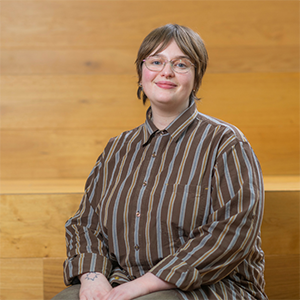
Laura explained that the Master of Art Therapy helped complete a piece of the puzzle in their arts studies, after previously completing a fine arts degree.
“When I graduated from my fine art undergrad I was left with a sense of disappointment and confusion about my own practice. I think a lot of artists who do a fine art degree are left with this at the end. When your work is constantly judged and assessed, you can develop a bit of a complex when you sit down to make art”, said Laura.
“Art was still important to me personally, but I didn’t feel I had the stamina or skills to work as a professional artist. I found out about art therapy when working on The Big Anxiety, an art and mental health festival in 2017.
“I realised this could be what I was looking for and allow me to combine my interest in art and my passion for care, social justice and working with community.’’
Learning the theories of Art Therapy has also helped Laura approach creating in new ways.
“It’s enabled me to let go of a lot of the fear of the blank canvas.
“I’ll often experiment with materials in a more therapeutic way; for example, using tools (bushes, pens, hands) in a more somatically directed movement – feeling in my body and expressing that through marks and caring less about how it looks aesthetically.
“In art therapy how the art looks is not important at all, so bringing that mentality helps me start work and activates the imagination.”
While finding a balance between art and study can be a challenge, Laura said they were lucky to be studying a discipline where art was a key part.
“We do get to make a lot of art in class and as part of our assessments, though it is through a more professional reflective and theoretical lens. I think of my own art practice as separate from what I create for class or during sessions. I have the privilege of having a studio at home, so I can make whenever I want which helps a lot!
“Unfortunately, during the semester (and definitely towards the end) my personal practice does take a bit of a back seat. I do try to use spare moments for simple sketching in my notebooks whenever I can and have the energy though, mostly planning bigger pieces for the breaks!”
For more information about the Archibald Prize and this year’s winners and finalists, visit the Archibald Prize finalists 2024 | Art Gallery of NSW
